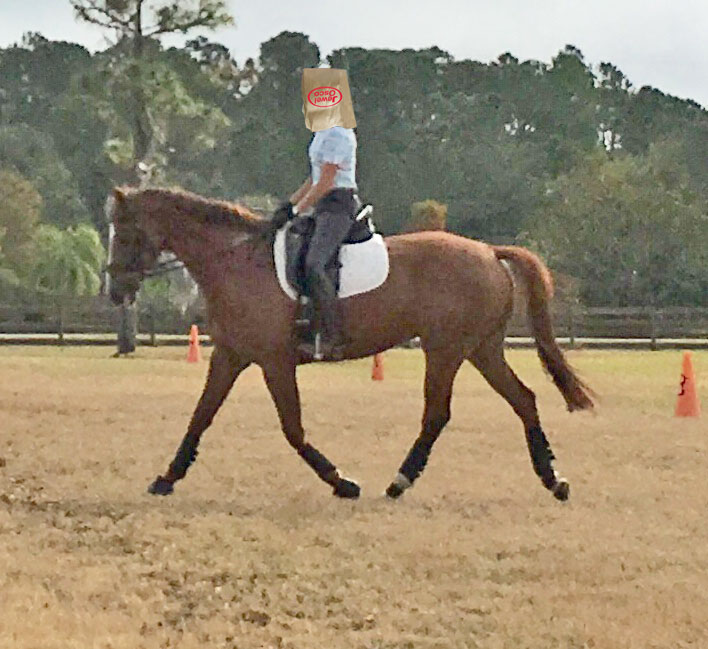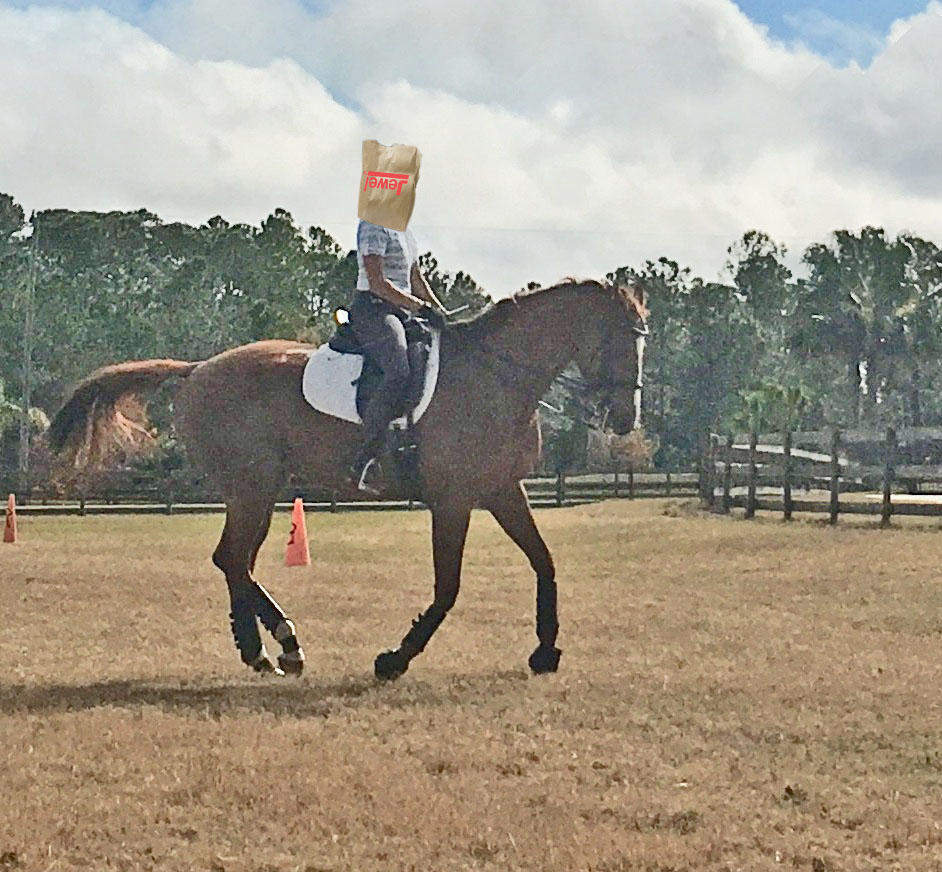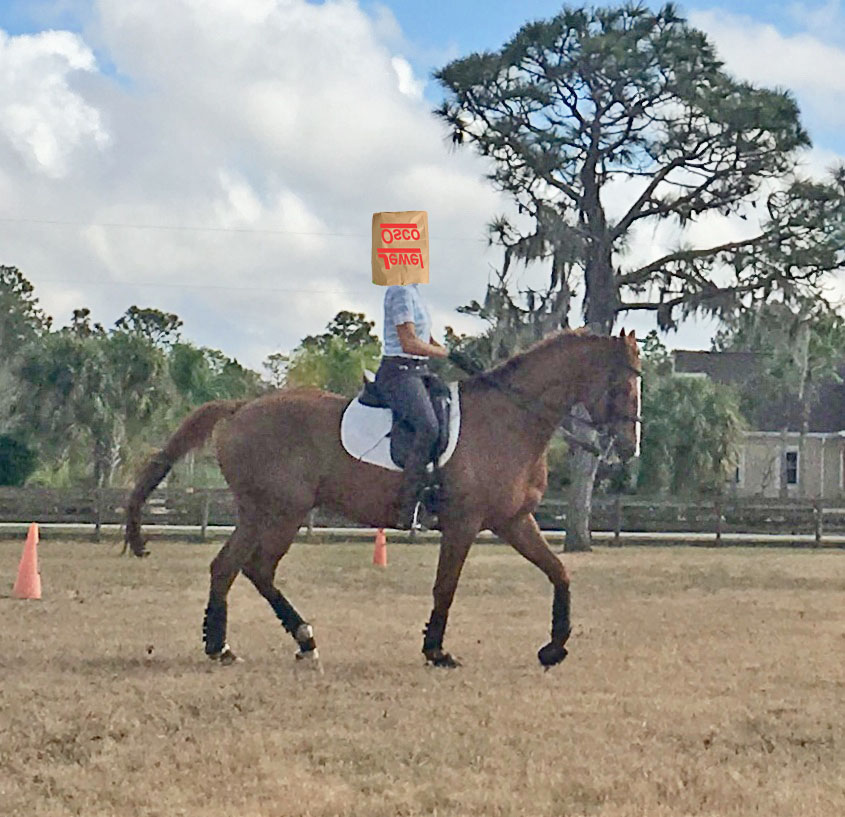(“As I’ve heard them say on TV, don’t try this at home.”)
“He’s heavy. Why is he so heavy? I thought he was supposed to be light. I saw on Face Book my aids are supposed to be light.”
It’s because, dare I say,You goofball My dear lady, you’ve been teaching him to be flat and impervious to rebalancing. What do you expect?
Allow me to apologize for my associate editor, Sidd Finch, who briefly seized the keyboard. He is less patient than I. He does seek to address a real problem however. It’s the “You’ve dug yourself a hole. How do I get you and your horse out of it so you can ride the way I want you to ride and feel what I want you to feel without in the meantime permitting you to do some things that I don’t want you to adopt as your routine long-term approach to your riding” conundrum.
Two caveats: as I say over and over, each situation is different, and I am more than aware of the “razor in the monkey’s hand” risk. [As I’ve heard them say on TV, don’t try this at home.]
 Here’s the situation: a nice horse—a Thoroughbred/Selle Français cross—with Training Level eventing experience (prior to purchase) under a professional rider.
Here’s the situation: a nice horse—a Thoroughbred/Selle Français cross—with Training Level eventing experience (prior to purchase) under a professional rider.
Further notes: The horse is a nice mover. As the photo attests, he goes in a perfectly acceptable First Level outline and, when ridden cleverly, scores in the mid 60s. He has been given reason to believe that this is to be the pinnacle of his dressage career. He has the talent to go on, but breaking through his penchant for leaning on the hand will require more strength and determination than the rider’s confidence level permits her to summon.
The rider sits decently and has read enough (too much?) so as to be very concerned never to do the wrong thing [See Sidd Finch’s aborted blog entry at the top of this page].
[Additional editor’s note: the rider has granted permission for the use of these photos but insisted that she wear a bag over her head to remain anonymous. Draw no conclusion that the bag is from the Naperville, Illinois, Jewel Supermarket. And be assured that she is diligently wearing her riding helmet with chinstrap inside the bag.]
And finally (before we begin) I note that this is yet another story with a happy ending where my methodology strays slightly from the most rigidly classical solution. In another lifetime things which would be nice to do: Put the rider on a schoolmaster. On her own horse have her take lessons three or four times a week and get on him myself each time as well. Have her make 10,000 transitions (which we will do anyway).
 No, what produced these changes in very short order was the substitution of a double bridle for his snaffle. I know what some of you may be thinking. “Are you just setting his head?” “Aren’t you supposed to ride the back end?” “Are you using the mechanical advantage of the curb to make a false lightness?” “Shouldn’t she learn to do it in the snaffle?” The answers in order are no, yes, no, and yes.
No, what produced these changes in very short order was the substitution of a double bridle for his snaffle. I know what some of you may be thinking. “Are you just setting his head?” “Aren’t you supposed to ride the back end?” “Are you using the mechanical advantage of the curb to make a false lightness?” “Shouldn’t she learn to do it in the snaffle?” The answers in order are no, yes, no, and yes.
This horse does think forward and, even with his owner, was in front of the leg. The curb reins were able to be slack the whole time. The horse stayed active—he was not resentful or sluggish. He did not retract or evade the contact. The poll remained the highest point, yet he was able to stretch and seek the ground when invited.
Lacking one or more of these qualities, you would have to do a cost/benefit analysis to decide if this was a wise course to pursue. In this case all the stars aligned. The rider experienced both a visual and tactile sense of what her horse should begin to feel like. She still had to work on the timing of her half halts, but instead of earning only frustration and a trip to the chiropractor, they worked! The goal, of course, is to change his expectations while developing his strength behind and a soft, round connection to the bit. As much as I reject the notion that you should look for solutions to your training problems in your tack trunk, in this case it is opening the way to a mutual understanding. In the not too distant future I hope I can post an update sans bag.

